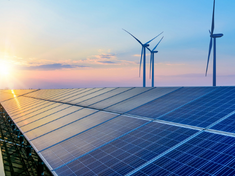-
Meeting the Global Energy Transition: A Conversation with Jonathan Pershing
November 10, 2022 By Amanda King
“Things that we used to think were 20 or 30 years into the future are in fact happening today… Climate change is noticeably changing the extent, the severity, and the frequency of these kinds of events.”
This stark assessment from Jonathan Pershing, Program Director of Environment at the William and Flora Hewlett Foundation, is at the center of a discussion of progress made and needed for international climate commitments, the role of critical minerals in the green energy transition, and climate-related migration trends with ECSP Senior Fellow Sherri Goodman and ECSP Program Associate Amanda King in this week’s episode of New Security Broadcast. Pershing brings a wealth of perspective to the conversation, drawing on his roles formally supporting Special Presidential Envoy for Climate John Kerry, and serving both as a Special Envoy for Climate Change at the U.S. Department of State and lead U.S. negotiator to the U.N. Framework Convention on Climate Change.
“Things that we used to think were 20 or 30 years into the future are in fact happening today… Climate change is noticeably changing the extent, the severity, and the frequency of these kinds of events.”
This stark assessment from Jonathan Pershing, Program Director of Environment at the William and Flora Hewlett Foundation, is at the center of a discussion of progress made and needed for international climate commitments, the role of critical minerals in the green energy transition, and climate-related migration trends with ECSP Senior Fellow Sherri Goodman and ECSP Program Associate Amanda King in this week’s episode of New Security Broadcast. Pershing brings a wealth of perspective to the conversation, drawing on his roles formally supporting Special Presidential Envoy for Climate John Kerry, and serving both as a Special Envoy for Climate Change at the U.S. Department of State and lead U.S. negotiator to the U.N. Framework Convention on Climate Change.
As the world is currently tuning in to the 2022 United Nations Climate Change Conference (COP27) in Sharm El-Sheikh, Egypt, Pershing noted that the year since COP 26 occurred in Glasgow “really feels like a bit of a tipping point in the scale.” One notable yardstick can be found in a comparison of the scales of global security dimensions and refugee crises occurring over the past year. While about 5 million people have been displaced by Russia’s invasion of Ukraine, and under 10 million compelled to move because of the ongoing conflict in Syria, he continued, climate catastrophe has displaced nearly 30 million people in Pakistan alone.
“One event, short term,” Pershing said.
Against this backdrop, Pershing observed that a key problem facing COP27 attendees is that “people have not been able to make as much progress as we’d like to have made.” Implementation is going to be hard, he said. “We know we’ve got the money now at the table, but how do you carry it forward?”
A central point of contention at this year’s conference is the long-standing commitment that the developed world would help the developing world transition to renewables. Pershing identified China as a major player in the global transition to renewable energy. “If we look at the total global development of renewable energy,” he said, “and divide up the world into two parts—one part is China.” Indeed, China’s slice of that pie “is as big if not bigger than the rest of the world combined in terms of its installation of new renewable capacity.”
Pershing considered that the world is not up to the scale needed for the coming decades in terms of obtaining the materials necessary for this energy transition. In examining the U.S. role in the renewable energy transition, for example, he noted that the U.S. has been historically reluctant to create the new facilities required for the essential minerals to make such a transition. Pershing also said that while the U.S. has a share in global mines, it is only a piece of the total amount. If the U.S. wants to build out its capacity for these resources, it will take a global network.
While the energy transition and mining for critical minerals can be a point of conflict, Pershing added that it may also be a possible point of cooperation between the U.S. and China. But what would such partnership look like? “It could occur in places where it doesn’t conflict with the underlying security tensions between the countries,” Pershing said, “but yet offers a real opportunity to transition to the future that we must have.” This common ground might include places where policy is central, and where information could be exchanged about creating more efficient and environmentally-sound mining operations. The Democratic Republic of Congo is one place suggested by Pershing as a nation offering the U.S. and China a chance to work together to minimize deforestation as global networks seek growing access to minerals.
Pershing concluded by offering the Global Methane Pledge as an example of the significant movement on climate change that might be realized via international climate commitments. Of the many flavors of greenhouse gases contributing to climate change, the dominant challenge is carbon dioxide, but the second most prominent contributor is methane. Yet for much of the history of climate negotiations, the dynamics of methane were underplayed. Pershing pointed to the hope offered by the growing number of countries joining the Global Methane Pledge, and pushing to realize the many near-term preventative measures that can be accomplished if the world works on reducing methane emissions. The pledge itself, he said, “could be the kind of model that helps shape some of the answers, not just to methane, but to carbon dioxide, and the other greenhouse gases.”
New Security Broadcast is also available for download on iTunes and Google Podcasts.
Sources: Global Methane Pledge
Photo Credit: Solar panels and wind power generation equipment, courtesy of hrui, Shutterstock.com.
 A Publication of the Stimson Center.
A Publication of the Stimson Center.




